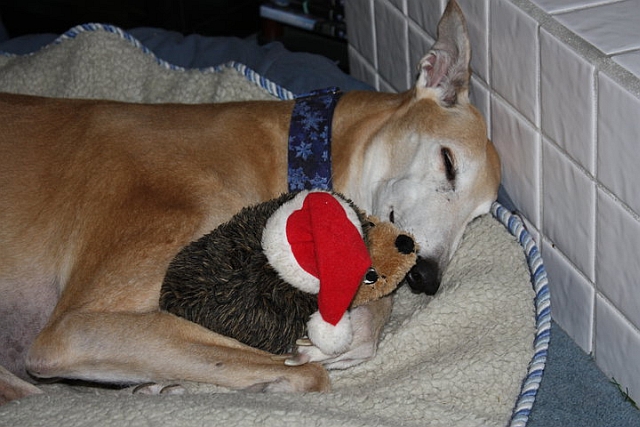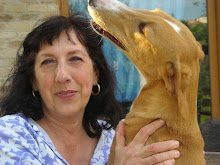senior citizen hounds
by Lynda Adame
I’ve never owned an older Greyhound. There, I feel much better being up-front with all of you about that fact. My own Greyhounds, Cody and Tice, are both middle aged dogs; still active, energetic, and healthy. Not too far down the road though, they will both enter their golden years and I want to be prepared for this inevitability. This led me to collect quite a bit of research and information about living with geriatric dogs, some of which might be useful to other Greyhound owners as their own dogs approach old age.
When is a Greyhound considered old?
Based on the information I have gathered, the aging process varies with breed and lifestyle. Most veterinarians consider large dogs (fifty-one to ninety pounds) old when they are nine to eleven and a half years of age. We are beginning to see Greyhounds, in adoptive homes, reach ages of twelve to sixteen years.
What are the physical changes an older dog might undergo?
Surprisingly, research shows that aging dogs experience many of the same changes that aging humans undergo. Loss of muscle tone is usually the most obvious change, resulting in the neck and body looking flabbier. Weight management should be a high priority as Greyhounds age, and weighing your dog every few months can give you a heads up on physical problems. Extra weight is hard on most dogs but is particularly difficult for an aging Greyhound, a breed that is meant to be lean. Daily grooming will keep you in touch with any new lesions, bumps, lumps, discoloration’s or bad breath. If you find anything suspicious, report it to your vet. It’s particularly important to note that female dogs spayed later in life are in a high risk category for mammary tumors; daily grooming will help detect these in your female Greyhound. Grooming also aids in circulation, assists the dog in grooming areas it can no longer reach, and helps distribute natural skin oils leading to a healthier coat.
An impaired resistance to temperatures, both hot and cold, can become apparent in a geriatric dog. Since Greyhounds are uniquely sensitive to heat and cold in their early years, be extra observant that their environment is neither too cold nor too hot as they age.
Arthritic joints may create aches and pains as a dog ages, making it more difficult for the Greyhound to keep its anal-genital region clean. Arthritis and joint pain management are a key area to monitor in a retired athlete. Even if your dog showed no joint sensitivity as a youngster, old injury sites can flare up as they calcify with age. This type of discomfort is treatable with a variety of medications including: over the counter pain medication (Ascriptin® for instance), prescription medication (vet-dispensed) such as Rimadyl®, as well as homeopathic treatments such as Glycoflex, and shark cartilage. Acupuncture is another option for a Greyhound with joint pain; check with your veterinarian for a referral. Greyhounds experiencing the aches and pains of arthritis will benefit from a soft padded surface on which to sleep. Egg crate foam is highly recommended for this purpose, as it cushions joints and evenly distributes a dogs’ weight.
Grooming Your Older Dogs
You may find you are spending more time as the toenails can require more frequent trimming and the dogs skin may begin to dry out. Loss of hearing may occur and should be suspect if your geriatric dog suddenly begins to ignore you when you speak to it. Problems in vision are a possibility. If your older Greyhound suddenly begins to bump into furniture, injures itself more often, or becomes fearful of common things (such as canine and human friends, or going for a W-A-L-K) consider that it’s vision may be failing and have your veterinarian take a look.
Tooth and gum disease are fairly common in the older dog, and Greyhounds are no exception. Most dental procedures require a dog be anesthetized for a short period of time. Be VERY certain that your veterinarian is using a Greyhound-safe anesthetic, such as Isoflurane. Geriatric pre-surgical panels are required by most veterinarians after a dog reaches eight years of age. A standard panel will include a CBC and Urinalysis.
Kidney disease and failure
Kidney disease and failure become more common as dogs age so keep an eye out for increased thirst and other symptoms of kidney failure. Most veterinarians recommend testing organ function at least once a year in older dogs. New research is showing that high protein levels in food do not lead to kidney dysfunction. However, protein levels are important to monitor if the kidneys are already showing impairment. Incontinence may appear in older spayed females (and even some males) and is treated with estrogen supplements.
While some conditions (like heart trouble) may preclude exercising your older Greyhound, most healthy dogs will benefit from some form of regular exercise to help keep their joints supple, their weight down, and their minds active. Walking is probably best for an older dog, even if it’s a slow walk.
To Vaccinate or Not to Vaccinate
Automatically vaccinating a dog every year, or every few years, is an area of much controversy and research these days. It is now possible for veterinarians to check a dog’s blood for appropriate antibody levels, rather than vaccinate the dog every few years. For older dogs, or dogs with compromised immune systems, this may be an interesting new approach to canine vaccinations. For further information, have your veterinarian contact Colorado State University at (970) 491-1101 (ask for “Diagnostics”), or contact Protatek Reference Lab at (602) 545-8499.
What if your Greyhound becomes bed-ridden?
While this is an unpleasant thought, many dogs have spent content years in various stages of repose. Hammock-type beds are recommended because they disperse the pressure placed on the dogs’ body and allow urine to pass through where it can be soaked into padded Bedliners (purchased through hospital stores). Pressure sores will likely develop on bed-ridden dogs. To help prevent pressure sores you will need to move the dog from side to side and massage the pressure points often. Ammonia breaks down the keratin layer of the skin, making sores worse, thus keeping the dogs’ body elevated from its urine will help in treating and avoiding pressure sores. Desitin™ is wonderful to use on a bedridden dog as it forms a barrier between the urine and the dogs’ body, thus protecting the most delicate of skin. You can also dab liquid antacid (Maalox™) on the sores, after cleaning and drying the area. The antacid changes the pH of the skin and promotes healing.
Behavioral and Mental Changes
Older dogs tend to be more complacent, less energetic and less curious. They may be forgetful and sleep more. Crankiness and irritability are common. The senior dog may become less tolerant of changes in its environment. You may want to consider having someone check on the dogs in your home, rather than kenneling them, when you must leave on vacation. Kenneling an older dog can be extremely stressful and it’s not uncommon for them to go off their feed, become over-anxious, or bark frequently. Continuing to provide varied stimuli in their lives may help mitigate some of the more behaviorally rigid and less tolerant aspects of the aging process. This can be as simple as taking a different route on each day’s walk, or working on some easy training commands or tricks.
What are the mental changes older dogs may experience? Cognitive dysfunction is a new area of research, in canine geriatrics, and some amazing breakthroughs have been made in recent years. Cognitive dysfunction, also referred to as senility, is recognizable by the following signs: Inattention to environment, loss of house training and the inability to recognize familiar people, places, or animals. Other signs include confusion, changes in sleep cycle, decreased interest in food or unexplained weight loss, development of compulsive and/or repetitive behavior, tremors, shaking, whining and/or whimpering. Cognitive dysfunction can also manifest itself as Separation Anxiety in the older Greyhound. The latest research centers around treating the dog with l-deprenyl, a medication that appears to enhance cognitive function in many older dogs.
“Cognitive dysfunction, also referred to as senility, is recognizable by the following signs: Inattention to environment, loss of house training and the inability to recognize familiar people, places, or animals.”
The thought of our beloved Greyhounds aging is something most of us would rather not contemplate. It is a reality, however, and knowing what to expect can help us better deal with the problems and issues that might occur. These dogs have become an integral part of our families. They deserve to live out their lives in a dignified and well cared for manner, surrounded by those that they love and who love them in return. I plan to share many more years with Tice and Cody, and wish the same for you.
Webmaster’s note: Tice lived to the ripe old age of 15.

